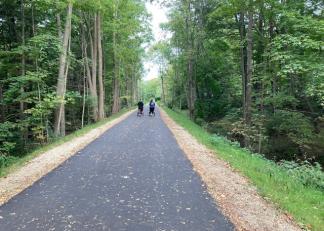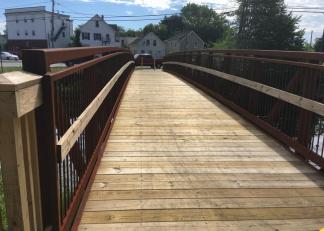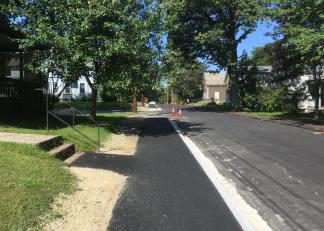Transportation Alternatives Program
The goal of the federally-funded Transportation Alternatives Program (TAP) is to provide choices for non-motorized users that are safe, reliable, and convenient.
TAP was created under a federal law known as Moving Ahead for Progress in the 21st Century (MAP-21) to consolidate many stand-alone programs into a single, more flexible program. Programs replaced by TAP are Safe Routes to School, Recreational Trails, Transportation Enhancement, and Scenic and Cultural Byways. The Recreational Trails Program is administered by the Department of Resource and Economic Development.
For more information on the TAP program contact Tom Jameson, P.E. TAP Program Manager at (603) 271-3462 or email thomas.e.jameson@dot.nh.gov
Upcoming TAP Funding
NHDOT anticipates starting a new Transportation Alternative funding round in late Fall of 2024, with final approval of new projects in June 2026.
Draft Schedule
Transportation Alternative Program projects begin through a standalone application process, and then are incorporated into the Department's Ten Year Plan process for final project selection. Below is a draft schedule listing the key milestones that need to be followed to submit a TAP application and the timeline for final award.
- Late Fall 2024 - NHDOT will ask for letters of interest from communities interested in a TAP Project.
- December 2024 - Required workshop for all potential applicants that explains the requirements to manage a federal project and other specifics about TAP funding
- January 2025 - Project applications are due.
- February-March 2025 - applications will be evaluated for eligibility and prioritized by Regional Planning Commissions and NHDOT.
- April 2025 - top prioritized applications will be included in the Draft 2027-2036 Ten Year Plan as funding allows, and applicants will be notified as to their application status.
- Summer 2025- Spring 2026 - GACIT, Governor and Legislative public hearings for the Draft 2027-2036 Ten Year Plan, including TAP applications.
- June 2026 - 2027-2036 Ten Year Plan is approved.
- Summer 2026 - TAP applicants are notified that their application will be funded.
- Once projects are scheduled for funding, municipal agreements will be sent to communities for signatures, and then NHDOT will work with the community to allow project to begin design.
Active Transportation Infrastructure Investment Program (ATIIP)
The Active Transportation Investment Program (ATIIP) is a new competitive grant program created by Section 11529 of the Bipartisan Infrastructure Law enacted as the Infrastructure Investment and Jobs Act (Pub.L.117-58) to construct projects to provide safe and connected active transportation facilities in active transportation networks or active transportation spines.
ATIIP-Bicycle and Pedestrian Program - Environment - FHWA (dot.gov)
For more information on the Transportation Alternative Program click on the Federal Highway Administration (FHWA) link below.
Transportation Alternatives - Environment - FHWA (dot.gov)
Training for LPA "Person in Responsible Charge"
Selected communities must designate a full-time employee as the person in responsible charge. This person must have authority to make financial decisions for the sponsoring organization. This individual must be LPA certified by the Department. If you are currently certified and seeking recertification you can request a test vs. attending the day long training. Please see links below for information.
TAP Round 4 Summary
2021 Grant Round:
$13.4 M Total Funds (20% match required for $10.7M Fed)
4 years of funding
$1.25 M max funding per project
34 applications received requesting $25.1M in federal funds
Map - Location of TAP applications
Criteria for Scoring
Project Readiness and Support 13%
Financial Readiness 15%
Feasibility 9%
Stress Analysis 12%
Improve Safety Conditions 16%
Network Connectivity 20%
RPC Rankings 15%
Funded Applications:
- Ranking: 1
- Town/City:: Claremont
- 21-13 TAP Application
- Ranking: 2
- Town/City:: Nashua
- 21-28 TAP Application
- Ranking: 3
- Town/City: Rochester
- 21-07 TAP Application
- Ranking: 4
- Town/City: Warner
- 21-06 TAP Application
- Ranking: 5
- Town/City: Manchester
- 21-08 TAP Application
- Ranking: 6
- Town/City: Laconia
- 21-01 TAP Application
- Ranking: 7
- Town/City: Concord
- 21-14 TAP Application
- Ranking: 8
- Town/City: Merrimack
- 21-26 TAP Application
- Ranking: 9
- Town/City: Waterville Valley
- 21-05 TAP Application
- Ranking: 10
- Town/City: Rye
- 21-31 TAP Application
- Ranking: 11
- Town/City: Derry
- 21-15 TAP Application
- Ranking: 12
- Town/City: Keene
- 21-19 TAP Application
- Ranking: 13
- Town/City: Newport
- 21-17 TAP Application
- Ranking: 14
- Town/City: Gorham
- 21-18 TAP Application







